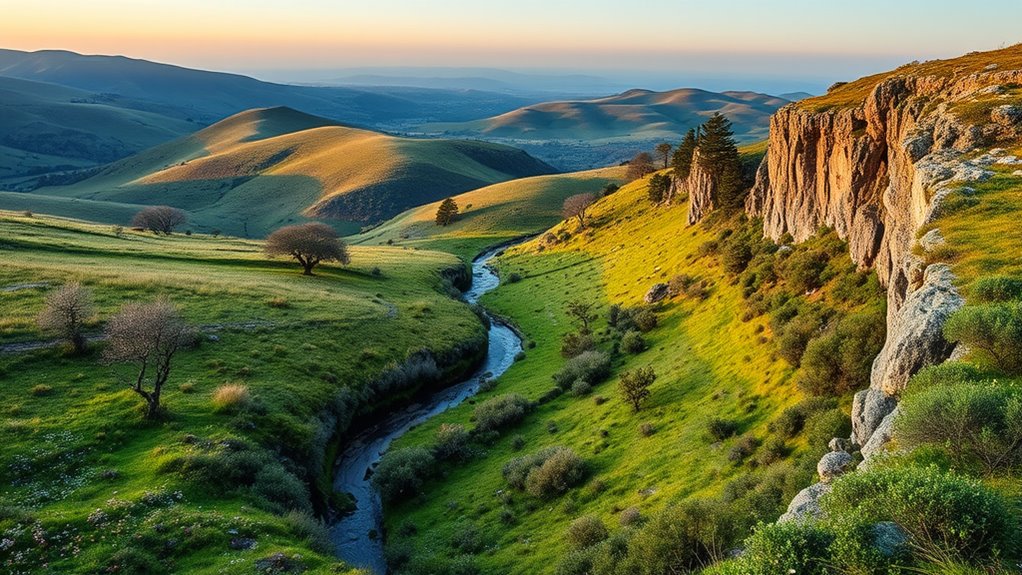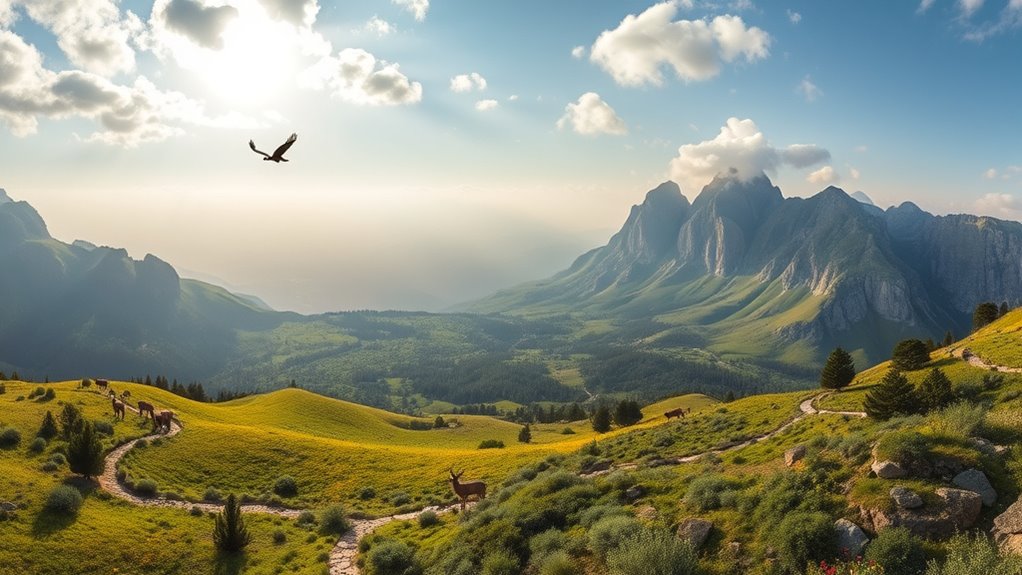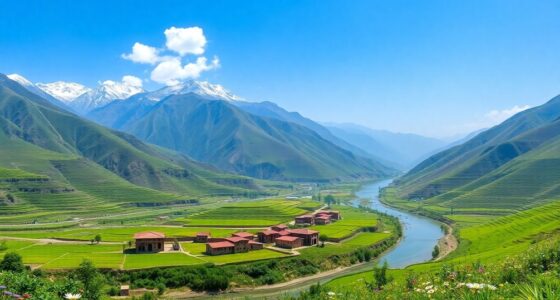Rewilded landscapes of the Iberian Highlands are transforming as land abandonment allows native plants and species to return. You’ll see ecosystems regain balance through natural processes like reintroducing keystone animals and managing wildfires. These efforts preserve cultural traditions while boosting biodiversity. If you keep exploring, you’ll uncover how innovative techniques and community efforts are shaping a thriving, resilient landscape that reconnects nature and heritage in powerful ways.
Key Takeaways
- Rewilding efforts restore natural processes by reversing woody plant encroachment and reintroducing keystone species like beavers.
- Native predators such as Iberian lynx and Spanish imperial eagle are returning, aiding ecological balance.
- Techniques include controlled burns and species reintroductions to mimic natural disturbances and promote biodiversity.
- Cultural heritage is preserved through traditional land management practices like grazing, strengthening local identities.
- Challenges include managing invasive species and climate change, requiring community collaboration and sustainable strategies.
The Transformation of the Iberian Highlands Through Rewilding

The Iberian Highlands have undergone a remarkable transformation thanks to rewilding efforts that aim to restore natural ecosystems. Historically, traditional grazing kept the landscape open and maintained a balance between grasslands and shrublands. However, in recent decades, land abandonment has increased as farmers left their fields, leading to the decline of grazing practices. This shift has allowed woody plants to take over, transforming open pastures into dense thickets and forests. Rewilding initiatives focus on reversing these changes by encouraging natural succession and reducing human intervention. As a result, the landscape is gradually returning to a more natural state, promoting biodiversity and healthier ecosystems. You can see how these efforts are reshaping the Highlands, restoring balance and fostering resilience. Utilizing natural materials, such as native plants and organic farming methods, further enhances the ecological recovery of the region.
Key Species Making a Comeback in Restored Ecosystems

As rewilding efforts restore natural habitats in the Iberian Highlands, several key species are making notable comebacks, signaling healthier and more resilient ecosystems. Native predators, like the Iberian lynx and Spanish imperial eagle, are returning in greater numbers, helping control prey populations and maintain ecological balance. Migratory birds, such as storks and raptors, are now frequent visitors, benefiting from improved habitat quality and reduced human disturbance. These species play critical roles in the food chain and seed dispersal, demonstrating the success of rewilding initiatives. Their resurgence indicates that ecosystems are becoming more self-sustaining and robust. Ecosystem resilience is further strengthened when keystone species recover, promoting biodiversity and ecological stability. Watching these key species thrive reaffirms the importance of ongoing conservation efforts and the potential for natural processes to restore harmony across the highlands.
Restoring Natural Processes: Techniques and Strategies

Restoring natural processes in the Iberian Highlands involves a range of targeted techniques and strategies designed to reestablish ecological dynamics. You might reintroduce keystone species like beavers, whose dam-building restores wetlands and controls water flow. Wildfire management is also essential; techniques like controlled burns reduce fuel loads and prevent destructive fires. These strategies help maintain healthy, resilient ecosystems by mimicking natural disturbances and processes. Incorporating risk assessment into these efforts ensures that potential challenges are identified and mitigated effectively.
Cultural and Ecological Significance of Rewilding Efforts

Rewilding efforts in the Iberian Highlands go beyond ecological restoration; they also reshape cultural identities and community values. As landscapes recover, you’ll notice a revival of medieval heritage, reflected in preserved ruins and ancient land-use patterns that connect communities to their history. Rewilding encourages the continuation of traditional practices, like grazing and forest management, which sustain both ecological balance and cultural traditions. These efforts foster a sense of pride and belonging, strengthening local identities rooted in centuries-old ways of life. By restoring natural processes, you help preserve intangible cultural heritage that defines the region. Additionally, integrating leadership skills into community projects can facilitate greater collaboration and long-term success of rewilding initiatives. This synergy between ecology and culture highlights how rewilding can revitalize the social fabric while safeguarding the landscape’s historical significance.
Future Perspectives and Challenges in Highland Conservation

Looking ahead, conserving the Highland landscapes faces both promising opportunities and significant obstacles. Effective invasive species management will be pivotal to restore native ecosystems and prevent biodiversity loss. You’ll need to develop adaptive strategies that respond to changing conditions and new threats, especially as climate resilience becomes increasingly essential. Climate change poses challenges like altered rainfall patterns and temperature shifts, which threaten native species and ecosystem stability. You can support efforts by promoting sustainable land use and restoring natural habitats to bolster resilience. Collaboration among local communities, scientists, and policymakers is indispensable to address these challenges. Additionally, understanding the cost and budgeting aspects of conservation projects can help ensure sustainable funding and resource allocation. While obstacles remain, proactive conservation measures can safeguard the Highlands’ unique landscapes and guarantee their ecological health for future generations.
Frequently Asked Questions
How Do Local Communities Benefit From Rewilding Projects?
You benefit from rewilding projects through increased biodiversity preservation, which boosts local ecosystems and attracts eco-tourism. This can create new job opportunities and stimulate the economy. Additionally, cultural revitalization occurs as traditional practices and local heritage are conserved or rediscovered, strengthening community identity. By supporting these initiatives, you help maintain natural beauty, improve quality of life, and ensure sustainable development for future generations in your area.
What Are the Economic Impacts of Rewilding on Tourism?
You’ll notice that rewilding boosts tourism by creating wildlife corridors and eco-tourism development. These initiatives attract nature lovers, birdwatchers, and adventure seekers, increasing visitor numbers and spending. As a result, local businesses thrive, and employment opportunities grow. You benefit from a more vibrant economy, and communities can invest in infrastructure and conservation efforts, creating a sustainable cycle that supports both nature and local livelihoods.
Are There Any Potential Conflicts With Agricultural Activities?
You might face conflicts with agricultural activities when balancing land use and conservation policies. Rewilding can restrict farmland, affecting farmers’ livelihoods and land management practices. These conflicts often stem from competing priorities—preserving ecosystems versus supporting local agriculture. To address this, you need to develop policies that promote coexistence, ensuring conservation efforts don’t undermine agricultural productivity, while respecting farmers’ needs and fostering sustainable land use.
How Is Climate Change Influencing Rewilding Strategies?
Climate change critically influences rewilding strategies by emphasizing climate adaptation and boosting ecological resilience. You need to take into account shifting weather patterns, temperature increases, and extreme events, which can threaten existing ecosystems. By focusing on creating resilient habitats, you help guarantee long-term success of rewilding efforts. Your strategies should prioritize native species, adaptable landscapes, and connectivity to allow ecosystems to withstand climate impacts and recover more effectively over time.
What Role Do Indigenous Knowledge and Practices Play?
You recognize that indigenous knowledge and practices are essential to rewilding efforts. Traditional farming techniques, passed down through generations, help maintain biodiversity and ecosystem balance. By integrating cultural preservation with ecological goals, you guarantee sustainable land use that respects local heritage. This approach fosters community engagement, enhances conservation, and supports resilient landscapes, making rewilding more effective and culturally meaningful.
Conclusion
Your journey into the rewilded Iberian Highlands reveals a landscape on the brink of transformation. As key species return and natural processes regain their rhythm, the future of this ecosystem hinges on ongoing efforts and unforeseen challenges. Will these efforts be enough to sustain the rebirth, or will new threats emerge from the shadows? The story is far from over—what happens next could redefine the very fabric of these highlands. The next chapter is waiting to be written.










